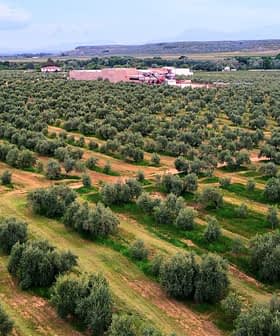 7.9K reads
7.9K readsNews Briefs
Despite Falling Prices at Origin, Olive Oil Retail Prices Remain Elevated
High olive oil prices in Europe have increased significantly, with prices 45 percent higher than the previous year. Poor harvests in the Mediterranean basin have contributed to the rise in prices, prompting some governments to take action to mitigate the impact on households.
High olive oil prices have captured the public’s attention across Europe.
According to European Commission data, average olive oil prices at retail across the European Union’s 27 member states were 45 percent higher in June 2024 than the previous year. By comparison, average food prices increased by 1.3 percent over that period, while the broader fats and oils category increased by 13 percent.
Meanwhile, price tracker data published in April by The Grocer, a United Kingdom-based trade publication, show the average cost of white-label olive oil brands in the country’s largest supermarkets reached £7.38 (€8.60) per liter, a 42 percent increase compared to April 2023.
See Also:Bank of Spain Attributes Ongoing Inflation to Soaring Olive Oil PricesFurther data from the International Monetary Fund’s benchmark commodity tracker, determined by the largest exporter, show olive oil prices at $9,157 (€8,530) per ton in June, 27 percent above last year.
Rising olive oil prices have been fueled by two consecutive poor harvests across the Mediterranean basin, especially in Spain, paired with resilient demand.
While some analysts are concerned that high olive oil prices could resemble regressive taxes, disproportionately impacting low-income households, Lisa Paglietti, an economist at the United Nations Food and Agriculture Organization (FAO), disputes this notion.
“The term ‘regressive tax’ carries significant political and social weight, so it might be more productive to focus on the overall impact rather than framing it as a regressive tax issue,” she told Olive Oil Times. “Analyzing per capita consumption in relation to income levels could provide valuable insights.”
“Understanding the distributional impact of the price increase on different income groups is crucial to determine whether it constitutes a regressive tax,” Paglieti said. “If the rise in olive oil prices disproportionately affects lower-income individuals, it could be regressive.”
“However, if the price increase results from factors impacting all income levels equally, such as a global olive oil shortage, it might not be considered a regressive tax but rather a general rise in the cost of living,” she added. “I believe it has happened at all levels, affecting all income levels.”
Some governments have taken action to mitigate the effects of expensive olive oil on households.
Authorities in Turkey and Morocco enacted bulk export bans to increase the domestic olive oil supply and promote individually packaged exports, which command higher prices. However, producers and consumers in both countries have questioned the effectiveness of these measures.
Meanwhile, the Tunisian government announced plans to cap the price of olive oil on the domestic market at 15 Tunisian dinars (€4.45) per liter in December and put 10,500 liters of extra virgin olive oil aside for this initiative.
However, some consumers have disputed the effectiveness of these efforts and alleged that they are not well enforced.
In Spain, authorities took a different approach, removing the Value Added Tax, similar to a sales tax, from olive oil and other kitchen staples to help households cope with rising living costs.
This decision was made in response to major retail chains’ price increases for olive oils, which have caused frustration and protests among the Spanish people who heavily consume this ingredient.
While olive oil prices at origin in Spain have fallen by 25 percent from the record-high levels reached in mid-January, prices at retail have not followed suit.
This is mainly due to prevailing market dynamics. Many retailers purchased the olive oil they were currently selling between November 2023 and January 2024 when prices at origin were approaching their record high.
As a result, they need to sell the olive oil at a higher markup to make a profit, even as prices at origin have fallen.
Other drivers of high retail prices are companies hedging against potential losses from another poor harvest and speculation by companies that buy olive oil and hold onto it before reselling it at a higher price later on.
As retail prices remain high, consumers may reduce their consumption or switch to cheaper alternatives. This can decrease demand, lowering retail prices as the market adjusts.
Changes in global demand for olive oil may also impact olive oil prices at European retail.
As the appetite for olive oil grows in non-traditional markets, producers and exporters will divert more of their product there, where they can habitually charge higher prices, leaving less for traditional markets.
“It’s important to recognize that non-traditional olive oil-producing countries, outside of the E.U., now account for a larger share of total olive oil consumption,” Paglieti said. “Producers and distributors should embrace the challenge of product differentiation and market development, especially for those olive oils marketed based on quality rather than price.”
“While every market and niche is unique, producers may need to adapt their strategies in newer markets,” she added. “Without market development efforts, there might be a higher degree of price elasticity of demand, and non-traditional markets could present greater growth potential in the future.”
Consumer agencies, such as Spain’s Organization of Consumers and Users (OCU), a non-profit consumer price watchdog, have offered valuable advice on cost-effective methods for purchasing olive oil without compromising its benefits.
Recommendations include buying larger formats (which decreases the price per unit), properly storing olive oil to last as long as possible, taking advantage of promotional discounts, reducing the amount used in each preparation and supporting local producers.
Paglieti recommends buying different grades of olive oil for various purposes. For example, keep the expensive bottle of extra virgin olive oil for finishing dishes such as salads while using a virgin or non-virgin for sauteéing and baking.
“A high-quality fruity oil, with its strong seasoning power and distinct sensory characteristics, can be used in smaller quantities and reserved for special occasions or special dishes, thereby reducing the economic impact since it is generally more expensive,” she said.
“More ordinary and less costly extra virgin oils can be used for cooking and as a base preparation for dishes,” Paglietti added. “Another suggestion is to buy smaller packages of high-end products to reduce the checkout amount and ensure a high rotation stock, considering these products are consumed in smaller quantities.”









